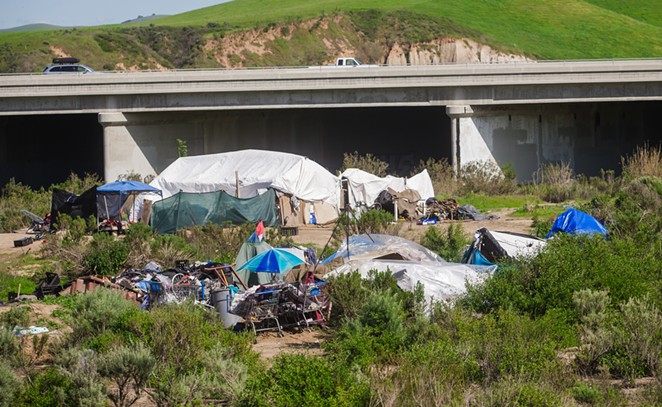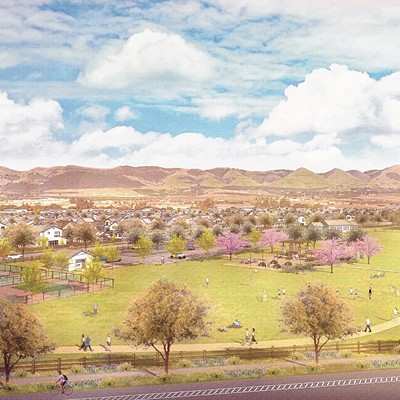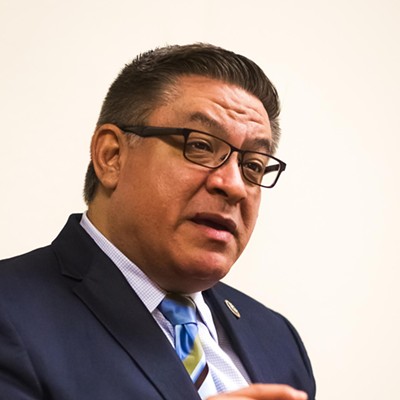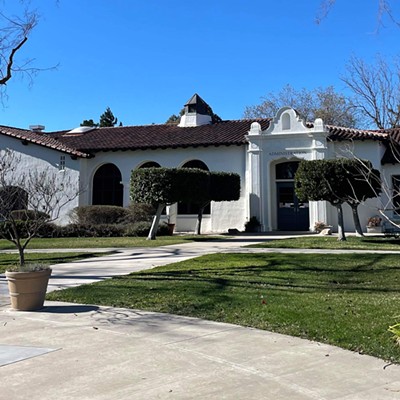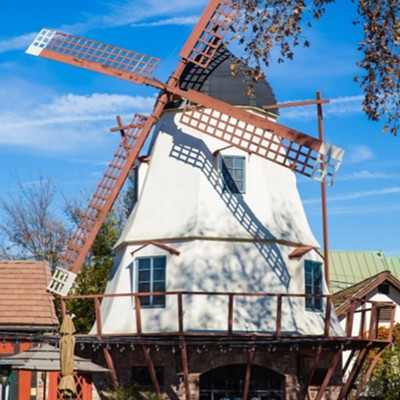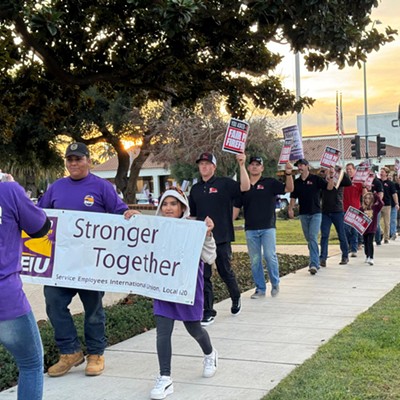Santa Barbara and San Luis Obispo Counties are teaming up to address a growing number of homeless encampments in the Santa Maria Riverbed.
A $6 million grant Gov. Gavin Newsom awarded to Santa Barbara County in 2023 aims to clean up encampments, including in the Santa Maria Riverbed between Santa Barbara and SLO counties that’s visible from Highway 101.
“Collaboration with Caltrans and San Luis Obispo County will address homelessness among a transient population between the city of Santa Maria in Santa Barbara County and more rural areas in San Luis Obispo County,” according to a 2023 Santa Barbara County newsletter.
Santa Barbara County 4th District Supervisor Bob Nelson told the Sun that one of the unique things about this deal is that even though Santa Barbara is the lead agency that asked for the $6 million grant, $3 million of that money will be used in SLO County.
“The county of San Luis Obispo supported us by writing a letter of support so we could receive this grant, and right now we’re having some conversations and it’s been a little painful, but I think we’re getting there on the cooperation,” he said.
However, Nelson said that there have been minor complications while trying to plan with SLO County about building more shelter beds.
During brainstorming sessions about how to house the estimated 110 to 150 people currently living in the riverbed, Santa Barbara County suggested that both counties build new shelter beds. After coming up with a number they thought was fair, Santa Barbara County said it would contribute 80 percent of the beds and SLO County should build 20 percent, but SLO County didn’t seem interested, Nelson said.
“We kind of went back and forth on our side trying to figure this out, so we ultimately said that we’ll have the beds because the odds are that they’re probably coming to us,” he said. “So we told them we just need to make sure that you guys cooperate with us when we do these evictions because this is your jurisdiction and we need your law enforcement involved.”
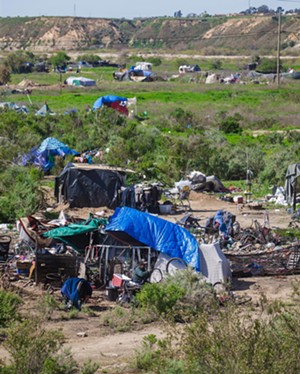
While the Santa Maria Riverbed is in SLO County, only 10 percent of those living there identify as SLO County residents, said SLO County Deputy Director of Social Services Linda Belch, which is why Santa Barbara County is taking the lead on this project.
With an already overwhelming amount of people on waiting lists to get into shelters in SLO County, that extra 10 percent would stretch SLO’s resources very thin, she said.
Wendy Lewis, CEO of the El Camino Homeless Organization (ECHO), said that between the nonprofit’s two shelters in Atascadero and Paso Robles, ECHO currently has a 200-person waitlist.
“Even though someone’s on the waitlist, they can already get started with a case management program,” she said. “We also offer evening meals at both locations so they can start building community and having a sense of trust with us. We also offer showers, and we have clothing and other supplies, toiletries, and things for basic hygiene.”
Unlike a traditional emergency shelter, ECHO is a 90-day program which can give stability for those in need by offering them the opportunity to sleep in the same bed for three months so they can take the necessary steps back into housing, Lewis said.
ECHO isn’t the only shelter in SLO County with an extensive waitlist. SLO County 4th District Supervisor Jimmy Paulding said that the 5 Cities Homeless Coalition also has a 200-person waitlist for its overnight shelter beds, but he noted that new housing projects are in the works.
“5 Cities Homeless Coalition is in the process of completing a 30-unit transitional housing project in Grover Beach, which will give them 50 beds additional beds,” he said. “We’re also working on an 80-bed interim and supportive housing project in SLO, which is grant-funded through the state, and we’re trying to determine the best sites to construct that new housing facility.”
In addition, Paulding said the county is in a financial partnership with the city of San Luis Obispo to convert a Motel 6 into 76 units of permanent supportive housing.
Belch said that the Santa Maria Riverbed cleanup will be based on when those additional shelters become available, so the additional clients don’t overwhelm the county’s existing providers.
“This is going to be an 18- to 24-month process where we’re really going to engage with the individuals over there and try to navigate them to the new shelter that best meets their needs,” she said.
Santa Barbara County is also struggling with providing available shelters to the homeless population. Nelson said that a new 94-unit interim housing facility was planned to open March 16, and there’s already a waitlist.
According to previous Sun reporting, the facility known as Hope Village will give individuals 24-hour access to mental health care, drug and alcohol treatment, and Social Services with the goal of getting people into permanent housing. Run by Good Samaritan Shelter, the project aims to help house some of the 473 individuals experiencing homelessness in Santa Maria.
The original intention for the modular units, Nelson said, was that they wouldn’t be made available for those living in the riverbed because 10 would be dedicated to 18- to 24-year-olds exiting the foster care system and experiencing homelessness, 30 units dedicated to recuperative care after a hospital stay, and 54 to community members in general.
“I eventually caved and said that there will be a portion of these made available for a portion of this cleanup process so that we could get the number that we needed,” he said. “Mostly because SLO County wasn’t willing to offer any, so I had to make some of these available to make both projects work.”
Once the riverbed is cleared out, SLO County would need to provide law enforcement presence to ensure that the encampments don’t return, Nelson said.
“If we use $3 million to clear it and then the county goes, ‘OK, thanks’ and doesn’t do anything after that, then it’s all going to be for naught,” he said. “I mean, the biggest waste of taxpayer dollars.”
Paulding said the cleanup project is complex because the riverbed falls under different jurisdictions.
“The complicating factor is the fact that over 100 individuals … in the riverbed are mainly in the county of Santa Barbara’s jurisdiction, but they’re also in our jurisdiction as well. Then if you go under the freeway overpass, they’re in Caltrans jurisdiction, and beyond that, there are private parcels, undeveloped private parcels out there that create another layer of just having to coordinate with private property owners as it relates to right of entry,” he said.
While SLO County Sheriff Ian Parkinson is committed to helping with the encampment cleanup, Paulding said the issue really comes down to long-term enforcement, and SLO County is in the planning phase of building a Nipomo sheriff’s substation.
SLO County Sheriff’s Office Public Information Officer Tony Cipolla said that the Nipomo substation is in the very early phases of the design-build process.
“At this early stage of the project, an estimated completion date has not yet been established,” he said, adding that the station will be built on county-owned property on Tefft Street.
“From a long-term standpoint, having an increased law enforcement presence in Nipomo will not only reduce response times for typical calls for service,” Paulding said, “but also station a community action team deputy in South County that could work out in that area and do outreach with the homeless population in the riverbed.”
Reach New Times Staff Writer Samantha Herrera from the Sun’s sister paper at [email protected].


